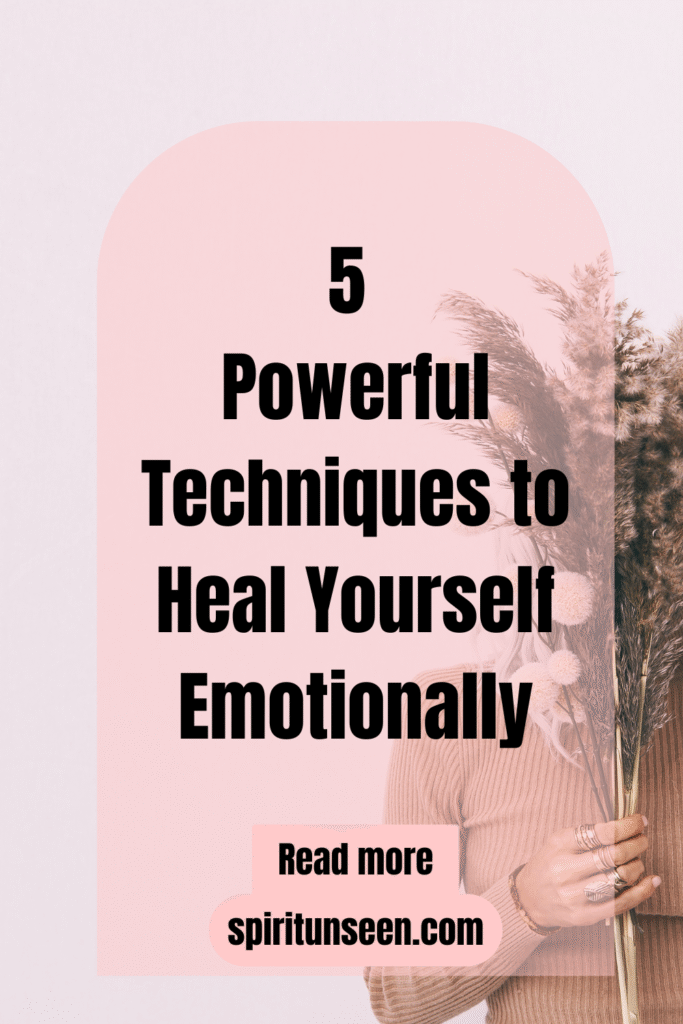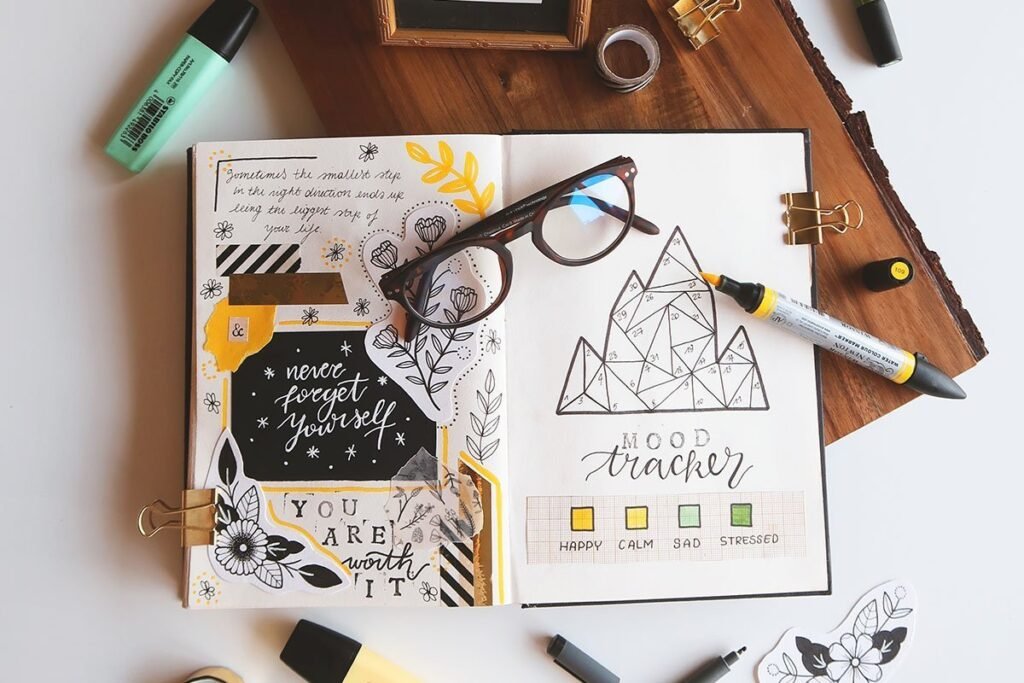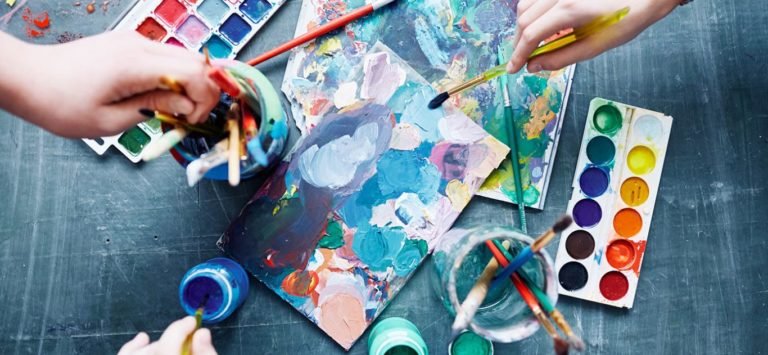
Healing emotionally is a process—one that asks for patience, self-awareness, and the right practices. Whether you’re carrying old wounds, navigating heartbreak, or struggling with lingering emotional pain, there are proven methods to help you release what no longer serves you and find your way back to balance.
In this article, we’ll explore five transformative emotional healing techniques designed to help you let go of negativity and reconnect with inner peace. Take a calming breath—and let’s start your journey toward emotional renewal.
If you haven’t read my previous article on https://spiritunseen.com/how-to-begin-your-self-healing-journey-5-essential-steps-for-inner-transformation/ I recommend you check it out first.
5 Powerful Emotional Healing Techniques to Restore Inner Peace

Emotional wounds often linger beneath the surface, influencing how we think, act, and relate to others. While healing isn’t instant, there are effective ways to gently release pain, rebuild your emotional resilience, and reconnect with yourself.
Below are five powerful techniques to support your emotional healing journey:
Journaling

Putting your thoughts and emotions on paper can be a deeply healing practice. It helps you release heavy feelings, make sense of what you’re going through, and become more in tune with yourself. Journaling offers a safe space to explore your inner world, gain clarity, and support emotional recovery.
To get started, find a quiet, comfortable spot, grab your notebook and pen, and simply begin writing whatever surfaces in your mind. If you’re unsure where to begin, try using prompts to guide your reflection.
Here are five journal prompts to encourage emotional healing:
- Think about a painful experience or challenging moment in your life. How did it impact you emotionally, and what are your honest thoughts about it?
- Write a letter to yourself from a place of compassion. What would you say to comfort and uplift yourself during this time?
- Recall a moment when you felt truly connected—to yourself or to others. What was happening then, and how can you invite that feeling back into your life?
- List any negative beliefs or critical thoughts you have about yourself. Then, gently challenge them by writing down reasons why they aren’t true.
- Reflect on a time when you accomplished something meaningful. How did it feel? Let that memory remind you of your strength and ability to overcome obstacles.
These prompts are simply a starting place. Feel free to make your own or follow your own flow. Journaling is a personal journey, and there’s no right or wrong way to do it—just let your truth come through the page.
Want more support? I’ve also created a printable journal filled with prompts designed to guide you through emotional healing—check it out for deeper reflection.
Mindful Meditation

Mindfulness meditation is a powerful tool for emotional healing. It teaches you to stay present with your thoughts and feelings—without judgment. Instead of pushing difficult emotions away or getting overwhelmed by them, mindfulness helps you observe them with gentle awareness.
To begin, find a quiet place where you can sit comfortably. Close your eyes and focus on your breath. Notice the sensation of air entering and leaving your body. When your mind wanders (which it will), simply bring your attention back to your breath—over and over again.
This practice encourages calm, clarity, and emotional balance. By regularly tuning into the present moment, you create space to process emotions instead of reacting to them automatically.
Even just 5–10 minutes a day can make a big difference in how you relate to yourself and your feelings. With time, mindfulness becomes a safe inner anchor—a place of peace you can return to no matter what life brings.
Breathing exercises

Breathing exercises are simple yet powerful tools to calm the mind, regulate emotions, and release stress. They work by engaging the body’s relaxation response, which helps reduce anxiety and bring emotional balance.
Here are a few effective techniques:
How to Practice Diaphragmatic Breathing:
Also known as belly breathing, diaphragmatic breathing helps activate the body’s natural relaxation response. Here’s a simple way to try it:
- Find a quiet space where you can sit or lie down comfortably. Place one hand on your chest and the other on your belly.
- Inhale slowly through your nose. As you breathe in, focus on expanding your belly—not your chest. You should feel your belly rise under your hand while your chest remains still.
- Exhale gently through your mouth. As you breathe out, feel your belly fall. Try to keep your breathing smooth and steady.
- Repeat for a few minutes. Aim for 5–10 slow breaths at your own pace. Focus on the movement of your belly and the rhythm of your breath.
With regular practice, diaphragmatic breathing can help calm anxiety, reduce stress, and support emotional healing.
Art therapy is a powerful emotional healing tool that uses creative expression to process deep feelings, release inner tension, and gain insight into the subconscious mind. You don’t need to be an artist—just the act of creating helps you explore emotions that are hard to put into words.
Art Therapy

Art therapy is a powerful emotional healing tool that uses creative expression to process deep feelings, release inner tension, and gain insight into the subconscious mind. You don’t need to be an artist—just the act of creating helps you explore emotions that are hard to put into words.
How It Helps:
- Gives form to emotions you may not fully understand.
- Provides a safe outlet for expressing anger, sadness, or fear.
- Encourages mindfulness and being present in the moment.
- Boosts self-awareness and self-acceptance through visual storytelling.
Ways to Try Art Therapy:
- Free Drawing or Doodling – Let your hand move freely on the page, no rules or expectations.
- Create an Emotion Wheel – Draw a circle and divide it into segments representing your current emotions with different colors or symbols.
- Paint Your Mood – Use colors and brushstrokes to visually express how you feel right now.
- Collage – Cut and paste images or words from magazines that reflect your emotional state or what you’re healing from.
- Draw Your Safe Space – Imagine a place where you feel totally at peace and draw it in detail.
The goal isn’t to create “good” art—it’s to release, reflect, and reconnect with yourself. If you’re interested, working with a licensed art therapist can also deepen the experience.
Yoga

oga is more than just physical movement—it’s a holistic practice that combines breath, body awareness, and mindfulness to support emotional well-being. By connecting with your body through gentle movement, you can unlock stored emotions, reduce stress, and cultivate inner calm.
How Yoga Supports Emotional Healing:
- Releases tension and trapped emotions from the body.
- Regulates the nervous system through breath and movement.
- Increases self-awareness and promotes a sense of grounding.
- Encourages acceptance, patience, and inner strength.
Best Yoga Practices for Emotional Healing:
- Restorative Yoga – Deeply relaxing poses held for longer periods to calm the mind and body.
- Yin Yoga – Slow, gentle stretching that targets connective tissue and emotional blockages.
- Heart-Opening Poses – Such as Camel Pose (Ustrasana) or Bridge Pose (Setu Bandhasana) to release grief and invite self-love.
- Child’s Pose (Balasana) – Offers a safe, comforting space for emotional surrender.
- Breath-Integrated Movement – Syncing your breath with slow, intentional movement helps release anxiety and tension.
You don’t need to be flexible or experienced. Simply start where you are. Even 10–15 minutes of gentle yoga a few times a week can make a noticeable difference in your emotional resilience and sense of peace.
Frequently Asked Questions (FAQs)
How long does emotional healing take?
Emotional healing is not a one-size-fits-all process. It varies for everyone depending on the nature of the emotional wounds, personal circumstances, and the support system available. Healing can take weeks, months, or even years—and that’s completely okay.
Can I heal emotionally on my own, or do I need a therapist?
Many people begin healing on their own using tools like journaling, meditation, yoga, or breathwork. However, professional support—like therapy or counseling—can be incredibly helpful, especially for deeper trauma or emotional pain that feels overwhelming.
What are signs that I’m healing emotionally?
Signs of emotional healing include feeling less triggered by past experiences, greater self-awareness, improved relationships, more emotional regulation, and an increased sense of peace or purpose.
I feel stuck. What should I do if healing doesn’t seem to be working?
Feeling stuck is normal. If self-help techniques aren’t moving you forward, consider reaching out to a therapist or counselor. You can also try switching or combining practices—like adding meditation to your journaling routine, or exploring emotional healing workshops or support groups.
s emotional healing the same as forgiving someone?
Not necessarily. Emotional healing is about releasing the pain, anger, or sadness you carry—even if you never forgive the person who hurt you. Forgiveness can be part of healing, but it’s a personal choice and not a requirement.
